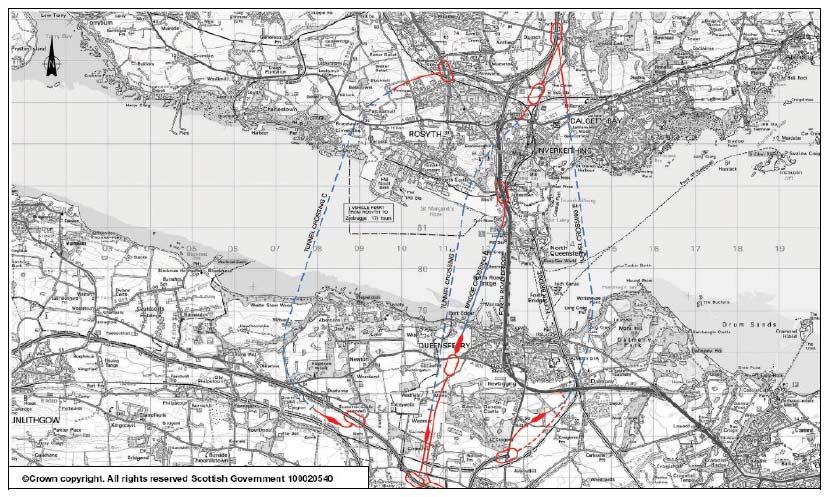2 Report Background 2.1 Introduction 2.2 Sustainable Development Objectives
2 Report Background
2.1 Introduction
This report provides summary information on the project development work carried out following the announcement to Parliament in December 2007 (see bibliography: report references 2 to 7), and reports on the further development work carried out to define and assess the Managed Crossing Scheme between August and November 2008.
Prior to the appointment of Jacobs Arup, Jacobs and Faber Maunsell were commissioned by Transport Scotland to undertake the Strategic Transport Projects Review. The review, which commenced in the summer of 2006, culminated in a report published on 10 December 2008 which detailed a portfolio of land based interventions to be taken forward, further developing Scotland’s transport infrastructure to meet the demands of the 21st century.
Given the urgent need to assess options for a replacement of the Forth Road Bridge, a separate Forth Replacement Crossing Study was commissioned under the umbrella of the Strategic Transport Projects Review. The Forth Replacement Crossing Study Reports 1 to 5 were published in 2007 and summarise the study development and findings.
The Forth Replacement Crossing Study was primarily concerned with determining the form, function and location for a replacement crossing. It made an assessment of five different crossing corridors and whether bridge and/or tunnels would be feasible solutions. It also confirmed that further development is required to determine the role, if any, that the existing bridge could take. Any decision on that issue required to await further information, including the Forth Estuary Transport Authority (FETA) Feasibility Study into Replacement/Augmentation of Main Cable report (subsequently published in February 2008).
Given that, at the time of the Forth Replacement Crossing Study, the long term future of the existing Forth Road Bridge was uncertain, the development of the Forth Replacement Crossing was progressed on the premise that the existing Forth Road Bridge may not be available for future use.
The expectations from emerging and current policies and action plans enabled the Scottish Government to develop eight specific transport planning objectives for the Forth Replacement Crossing. These are:
- to maintain cross-Forth transport links for all modes to at least the level of service offered in 2006;
- to connect to the strategic transport network to aid optimisation of the network as a whole;
- to improve the reliability of journey times for all modes;
- to increase travel choices and improve integration across modes to encourage modal shift of people and goods;
- to improve accessibility and social inclusion;
- to minimise the impacts of maintenance on the effective operation of the transport network;
- to support sustainable development and economic growth; and
- to minimise the impact on people, and the natural and cultural heritage of the Forth area.
The recommendation of the Forth Replacement Crossing Study was that the replacement crossing be a cable stayed bridge in ‘Corridor D’, immediately upstream of the Forth Road Bridge (see Figure 2.1). This new crossing would incorporate two lanes with hard shoulders plus pedestrian walkways/cycleway in each direction.
Figure 2.1: Bridge Corridor D was the selected location for the replacement crossing.

The Forth Replacement Crossing Study assessment work considered the various crossing options in relation to these objectives. The study findings formed the basis upon which the Cabinet Secretary for Finance and Sustainable Growth announced, on the 19 December 2007, that:
Having assessed all these factors the Government has come to the view that the Forth Replacement Crossing should be a cable-stayed bridge with multi-modal capacity on a route slightly to the west of the existing Road Bridge.
The replacement crossing is about more than just the crossing itself: the connections at either side are equally important. Providing a link to the M9 will allow greater choices and opportunities to West Lothian, whilst the construction of improved junctions in Fife will protect and promote access to the development areas of Fife. Including dedicated public transport will provide opportunities for those who travel into and around Edinburgh and offer improved opportunities for links more widely between Fife, Edinburgh and the Lothians.
The Forth crossing is a crucial part of the road network connecting communities on a local, regional and national scale and is overloaded due to single occupant cars during peak periods. This is only predicted to worsen in the future. Our key objectives of a wealthier and fairer and greener Scotland are well supported by this decision to protect cross-Forth travel whilst ensuring the flexibility and capacity to provide for other modes of transport including measures to ensure reliability of the crossing.
In January 2008, the Jacobs Arup Joint Venture was appointed by Transport Scotland to manage the delivery of the Forth Replacement Crossing Project.
Throughout 2008, Jacobs Arup has been engaged in the development of all aspects of the Forth Replacement Crossing Project, considering the replacement bridge, the Forth Road Bridge, the connecting road network and the road operating regime, and the environmental and sustainability aspects of each.
2.2 Sustainable Development Objectives
One of the main commitments made in the scheme objectives is ‘to support sustainable development and economic growth’ making it clear that the concept of sustainability is at the heart of the Forth Replacement Crossing Project.
Transport Scotland has set out a sustainable development policy for the scheme including a vision statement and objectives. The vision is:
‘To deliver an iconic project that respects the environment, contributes to sustainable economic growth at both regional and Scottish levels and facilitates efficient public transport whilst minimising disruption to the community and reducing the use of non-renewable resources during its construction and throughout its life’.
Beneath this vision is a set of sustainable development objectives detailed in Transport Scotland’s ‘Forth Replacement Crossing Sustainable Development Policy’. Consideration of sustainable development will form a core thread throughout all the activities of the project team and stages in the project life cycle including:
- Project design and appraisal;
- Preparation of contract documents;
- Tender evaluation;
- Construction;
- Maintenance;
- Operation